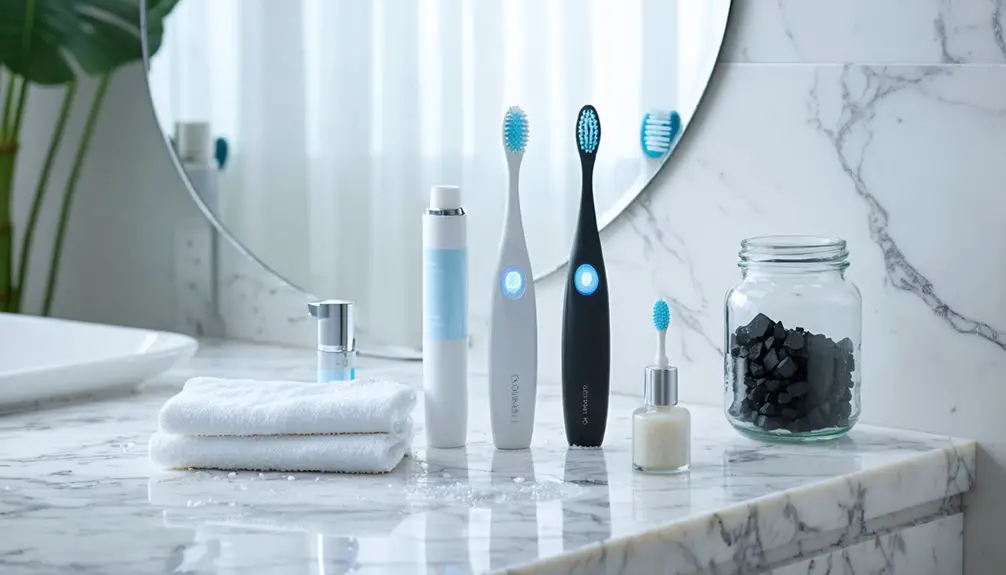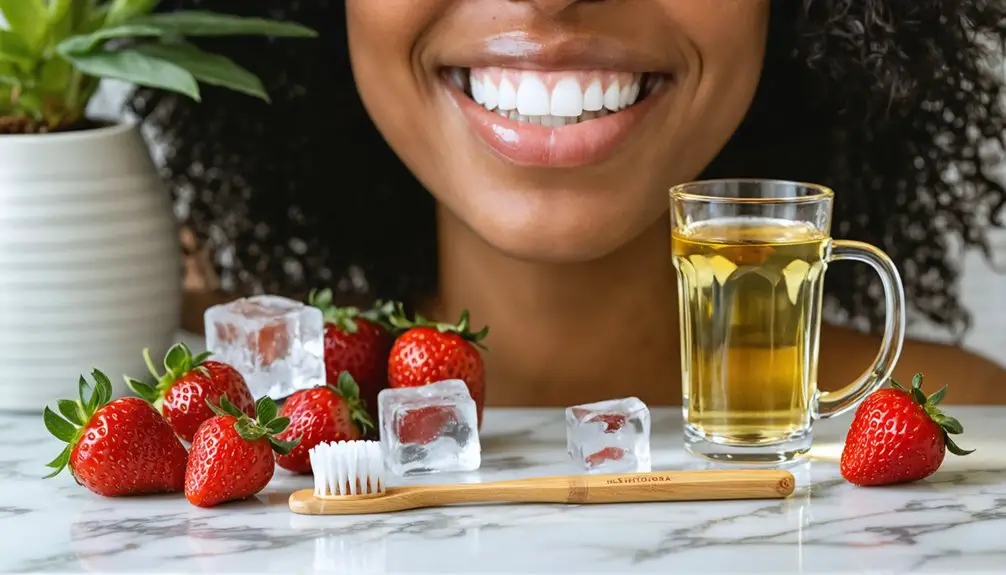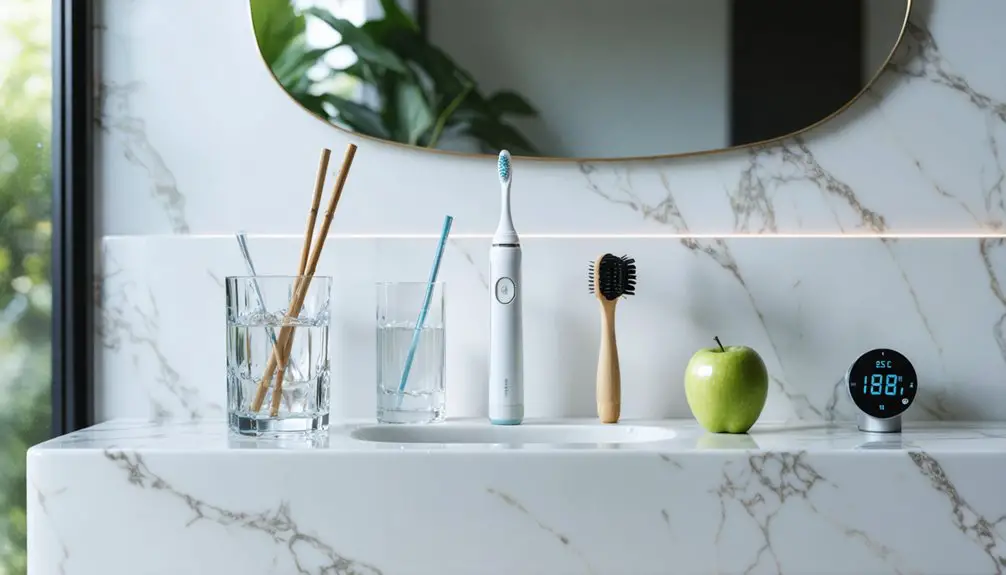To maintain bright teeth, you’ll need to combine proper oral hygiene with smart lifestyle choices. Brush twice daily using the Modified Bass technique with fluoride toothpaste, and floss before brushing. Avoid staining beverages like coffee, tea, and red wine, or rinse immediately after consumption. Use soft-bristled brushes, schedule regular dental check-ups, and consider professional whitening treatments. For ideal results, you’ll want to understand the complete strategy for protecting your smile’s brilliance.
Key Takeaways
- Brush teeth twice daily using fluoride toothpaste and the Modified Bass technique at a 45-degree angle for optimal cleaning.
- Rinse mouth immediately after consuming staining beverages like coffee, tea, or red wine, and wait an hour before brushing.
- Include crunchy fruits and vegetables in your diet for natural cleaning, and consume dairy products to neutralize harmful acids.
- Schedule professional whitening treatments every 6-12 months and follow up with recommended at-home maintenance procedures.
- Use soft-bristled toothbrushes, replace them every 3-4 months, and floss daily before brushing to maximize fluoride penetration.
Say Goodbye to Staining Foods and Drinks
Three main categories of foods and drinks are notorious for staining teeth: beverages rich in tannins, deeply pigmented fruits, and acidic sauces.
You’ll find that staining beverages like coffee, tea, and red wine contain tannins that bind color compounds to your enamel. Dark cola beverages can be particularly damaging due to their high acid content.
Dark berries and their juices combine natural pigments with acids that embed stains deep into enamel pores. Regular consumption can lead to significant tooth discoloration.
Similarly, acidic sauces including tomato, balsamic vinegar, and soy sauce create conditions for enamel erosion while depositing dark pigments.
To protect your teeth, limit your exposure to these staining agents.
When you do consume them, rinse with water immediately afterward.
Adding milk to tea can help reduce staining, as casein binds to the stain-causing compounds before they attach to your teeth.
Master Your Daily Oral Care Routine
You’ll achieve brighter teeth by mastering proper brushing techniques with gentle circular motions and daily flossing using the C-shaped method beneath the gumline.
Select high-quality, ADA-approved dental tools, including a soft-bristled brush, fluoride toothpaste, and antimicrobial mouthwash for ideal results. Dedicate at least two minutes to thoroughly brush your teeth twice daily for maximum effectiveness.
Maintain cleanliness throughout your day by rinsing after meals and waiting an hour before brushing to protect your enamel from acidic foods and beverages. For optimal oral health, consume calcium-rich dairy products that strengthen tooth enamel and promote dental wellness.
Effective Brushing And Flossing
Mastering proper brushing and flossing techniques forms the foundation of effective oral hygiene.
You’ll want to brush for two minutes twice daily using the Modified Bass technique, which involves gentle strokes at a 45-degree angle to your gum line. This method proves superior to other brushing techniques for removing plaque and protecting gum health. Despite the variety of recommendations from dental associations and companies, the Modified Bass technique remains the most commonly endorsed method. Experts recommend using gentle pressure to minimize the risk of gingival injury.
When flossing, curve the strand around each tooth and slide gently beneath the gum line to remove interdental plaque that brushing can’t reach. It’s best to floss before brushing to maximize fluoride penetration between teeth.
Remember to use soft-bristled brushes and replace them every three to four months. By combining proper brushing with daily flossing, you’ll create the most effective defense against cavities and gum disease.
Choose Quality Dental Products
Selecting quality dental products plays an essential role in achieving ideal whitening results. When choosing whitening product types, look for those containing hydrogen peroxide (around 15%) or carbamide peroxide (10-45%) as active ingredients. These concentrations effectively break down stains while maintaining enamel safety.
Consider your specific needs when selecting delivery methods. Custom trays offer superior fit and control, while strips provide convenient application. For targeted treatment, whitening pens work well on specific areas. Products with easy syringe delivery allow precise gel application for optimal results. Based on extensive testing data, LED light systems can enhance whitening by up to 2.6 shades in under three weeks.
If you’re sensitive to whitening agents, choose products containing amorphous calcium phosphate, fluoride, or potassium nitrate to minimize discomfort.
You’ll find effective options ranging from $10 drugstore kits to premium systems around $87. Always verify that your chosen products meet any dietary requirements (vegan, kosher, gluten-free) and follow usage instructions precisely.
Clean Throughout The Day
A robust daily oral care routine forms the foundation of effective teeth brightening. While most people know they should brush twice daily, only about half actually do. Research shows that brushing three times daily can cut your risk of major cardiovascular events by more than half compared to brushing just once per day. You’ll need to commit to proper technique and timing to achieve ideal results. Studies reveal that sixty percent of Americans brush both at bedtime and in the morning.
- Brush for at least 2 minutes using circular motions, focusing on all tooth surfaces – most people underbrush at just 45-135 seconds.
- Clean your tongue daily to remove bacteria that cause bad breath and affect tooth appearance.
- Support your brushing with proper daily hydration and sugar-free gum after meals to maintain pH balance.
- Use mouthwash and floss daily – while only 8% of people floss regularly, it’s essential for maintaining bright, healthy teeth by removing trapped particles between teeth.
Choose the Right Dental Tools
Proper dental tools serve as the foundation for achieving and maintaining bright, healthy teeth. Electric toothbrushes with oscillating motions remove more plaque than manual brushes, while soft bristles prevent enamel damage during cleaning.
When selecting your toothbrush, consider models with built-in timers and pressure sensors to optimize your technique.
Don’t overlook interdental cleaning tools. Water flossers effectively clean around braces and hard-to-reach areas, while traditional floss remains essential for removing debris between tight spaces.
For wider gaps, interdental brushes provide thorough cleaning. Pair these tools with appropriate toothpaste containing mild abrasives and fluoride to strengthen enamel while fighting stains.
Avoid highly abrasive formulas that can damage enamel and compromise your teeth’s natural brightness.
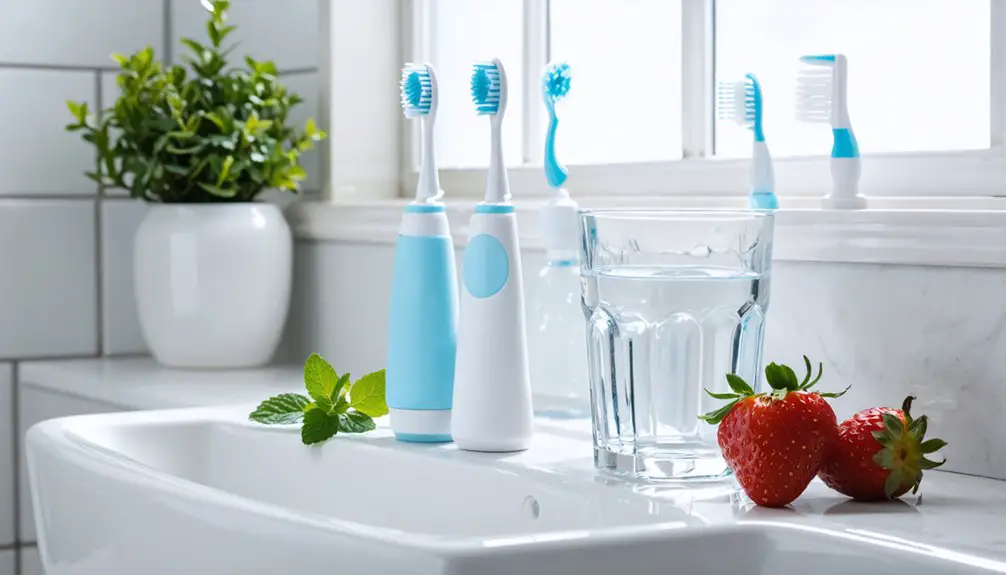
While teeth whitening effectively brightens your smile, it often triggers temporary sensitivity as bleaching agents penetrate the enamel and expose dentinal tubules connected to nerve endings.
Teeth whitening creates a brighter smile but may cause short-term sensitivity when bleaching opens pathways to dental nerves.
For ideal sensitivity relief and enamel protection, follow these essential steps:
- Avoid hot, cold, and acidic foods for 48 hours post-treatment, sticking to room-temperature, bland options that won’t aggravate sensitive teeth.
- Use desensitizing toothpaste containing potassium nitrate or fluoride, and brush gently with a soft-bristled toothbrush.
- Apply fluoride gel or rinse with warm salt water to strengthen enamel and soothe irritated gums.
- Contact your dentist if sensitivity persists beyond a few days or becomes severe, as professional desensitizing treatments may be necessary.
Smart Strategies for Drinking Beverages
Beverages you consume daily can greatly impact your teeth’s brightness, with certain drinks causing stubborn stains that diminish whitening results. To protect your smile, adopt smart drinking techniques when consuming staining beverages like coffee, tea, or red wine. Use a straw to direct liquid past your teeth, and rinse with water immediately after drinking these beverages.
Make strategic beverage choices that support dental health. Opt for tap or mineral water, which contain beneficial minerals and fluoride. When drinking tea, add 2% milk to reduce staining, as casein proteins bind with tannins.
Green tea offers a less staining alternative to black tea. After consuming pigmented drinks, incorporate dairy products like cheese or milk to neutralize acids and create a protective barrier against stains.
Wait 30 minutes before brushing to prevent enamel damage.
Transform Your Eating Habits
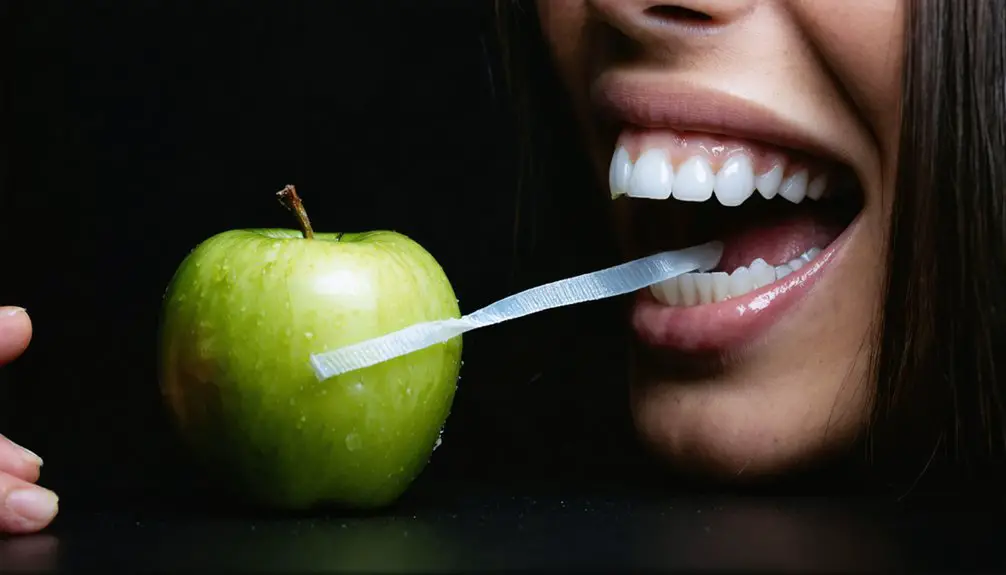
Beyond smart beverage choices, your eating habits play a central role in maintaining teeth brightness. Through mindful eating and healthy snacking choices, you’ll protect your smile while nourishing your body.
Smart food choices do more than nourish – they’re essential guardians of your bright, healthy smile through mindful eating habits.
- Prioritize crunchy fruits and vegetables like apples, carrots, and celery – they act as natural tooth scrubbers while stimulating beneficial saliva production.
- Include calcium-rich dairy products after meals, especially following acidic foods, to strengthen enamel and neutralize harmful acids.
- Add nuts and seeds to your diet for their mechanical cleaning action and essential minerals that support dental health.
- Minimize foods high in pigments or acidity, such as berries, tomato sauces, and dark spices, which can gradually reverse whitening effects through persistent staining.
Maintain consistent hydration to support your mouth’s natural cleansing mechanisms and protect enamel integrity.
Professional Care and Regular Check-ups
Although daily oral hygiene forms the foundation of dental care, professional cleanings and check-ups remain essential for maintaining ideal teeth brightness.
You’ll need a dental cleaning every six months, though more frequent visits may be necessary if you have risk factors like gum disease, diabetes, or smoking habits.
During your professional cleaning, your dentist will examine your oral health, remove stubborn tartar through scaling, and polish your teeth to eliminate surface stains.
They’ll often conclude with a protective fluoride treatment and personalized recommendations for home care.
These regular visits not only prevent plaque buildup but also allow for early detection of potential issues.
Essential Lifestyle Changes for Whiter Teeth
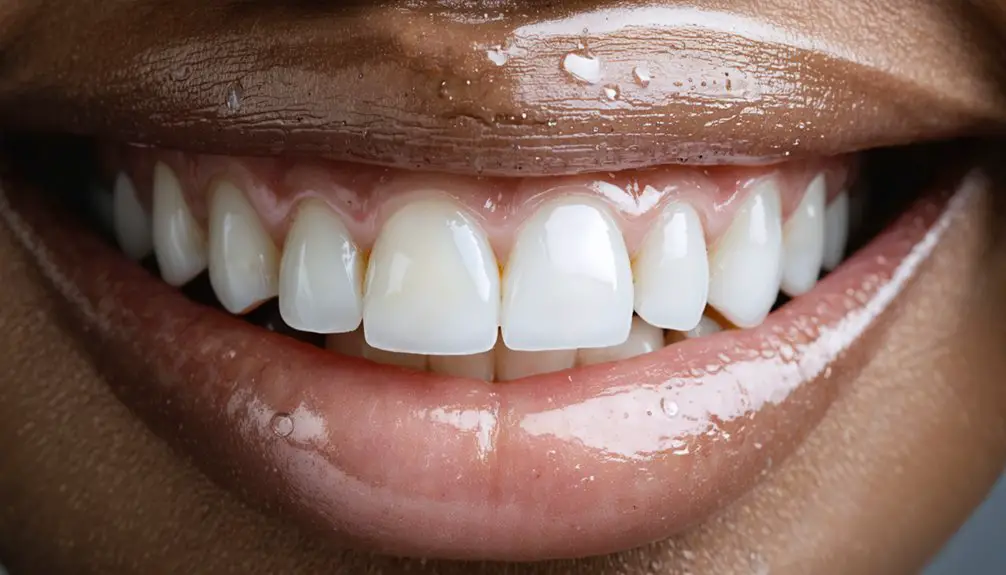
If you’re serious about achieving whiter teeth, you’ll need to quit smoking and limit your intake of staining substances like coffee, tea, and red wine.
You can protect your teeth’s whiteness by consuming crunchy vegetables that naturally clean teeth while eating, and by drinking water immediately after consuming staining beverages.
Making these essential lifestyle changes, combined with proper oral hygiene, will greatly improve your chances of maintaining brighter teeth long-term.
Quit Harmful Habits Now
While achieving whiter teeth requires dedication to proper oral care, eliminating harmful habits plays an equally essential role in preventing discoloration.
You’ll need to make conscious choices to protect your enamel and maintain a brighter smile.
- Quit smoking and avoid vaping immediately – these habits increase your risk of moderate to severe discoloration by up to 28%, with nicotine and tar causing stubborn stains that bond to your enamel.
- Stop using your teeth as tools, biting nails, or grinding – these actions create microfractures that trap stains.
- Cut back on acidic and dark beverages like cola, wine, and black tea – they erode enamel and contain staining compounds.
- Replace harsh whitening products with gentle alternatives – excessive abrasion can thin enamel and increase sensitivity.
Smart Food Choices Matter
Beyond eliminating harmful habits, making strategic food choices can greatly impact the brightness of your teeth. Incorporate malic fruits like strawberries and apples, which contain natural bleaching enzymes and stimulate saliva production.
These fruits work alongside nature’s toothbrushes – crunchy veggies such as celery, carrots, and broccoli – to scrub away surface stains while boosting protective saliva flow.
Don’t overlook dairy products’ role in your dental health. Cheese, yogurt, and milk provide essential calcium and lactic acid that strengthen enamel while promoting natural whitening.
They also help buffer your mouth against acidic foods that can erode teeth. Remember to rinse thoroughly after consuming acidic fruits and always maintain proper dental hygiene alongside these dietary choices.
Natural Methods to Preserve Tooth Brightness
Although professional teeth whitening treatments remain popular, natural methods for preserving tooth brightness offer scientifically-supported alternatives that don’t compromise enamel health.
You can maintain whiter teeth through gentle yet effective approaches that combine traditional and modern practices.
- Use natural abrasives like baking soda or activated charcoal occasionally for surface stain removal, being careful not to overuse these materials.
- Practice oil pulling with coconut or sesame oil for 10-20 minutes daily to reduce bacteria and plaque buildup.
- Create a gentle whitening paste by mixing baking soda with diluted hydrogen peroxide, using sparingly to protect enamel.
- Maintain results by avoiding staining foods and beverages, drinking plenty of water, and brushing after consuming items that could discolor teeth.
Timing Your Whitening Maintenance
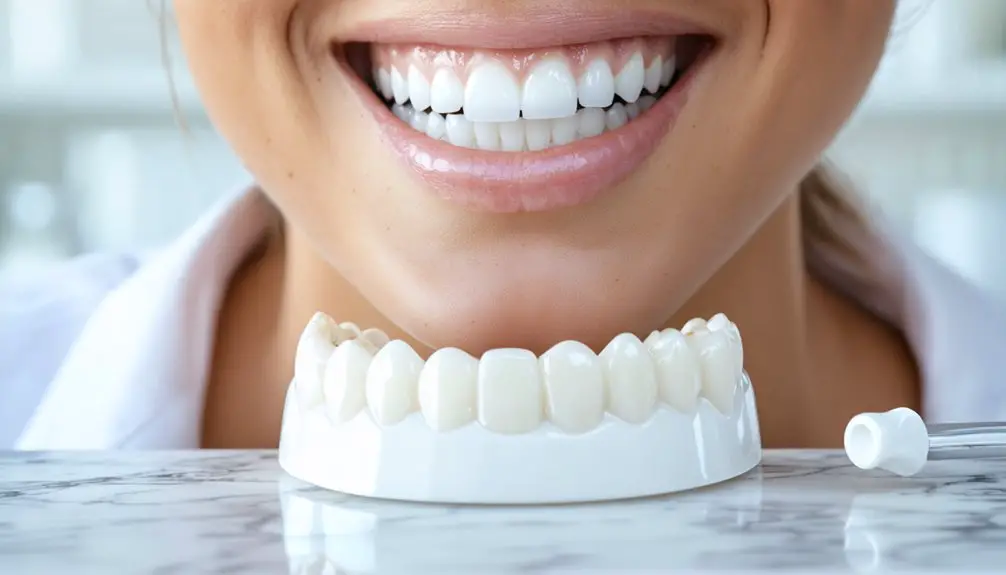
You’ll achieve ideal whitening results by scheduling professional touch-ups every 6-12 months, depending on your individual staining habits and tooth sensitivity.
Your maintenance treatments should include 3-4 consecutive days of whitening gel applications using custom trays for best effectiveness.
If you frequently consume staining beverages like coffee or red wine, you may need to adjust your maintenance schedule to more frequent intervals of every few months rather than annually.
Strategic Touch-Up Scheduling
Maintaining your teeth’s whitened appearance requires a strategic approach to touch-up scheduling based on your lifestyle habits and chosen whitening method.
Professional guidance can help you determine the ideal touch-up frequency that’s safe and effective for your specific needs.
- Schedule touch-ups every 6-12 months if you’ve had in-office whitening, but reduce intervals to 3-4 months if you regularly consume staining beverages.
- Coordinate whitening touch-ups with your routine dental cleanings to maximize effectiveness and monitor oral health.
- Plan touch-ups before any new dental work to guarantee proper color matching of restorations.
- Adjust your schedule based on your chosen whitening method – professional treatments typically require less frequent maintenance than at-home options.
Always consult your dental provider to create a personalized touch-up schedule that protects your enamel while maintaining your desired brightness.
Best Treatment Windows
Successful teeth whitening outcomes depend heavily on precise timing and adherence to post-treatment windows. Your enamel protection is most critical during the first 48 hours after whitening techniques are applied, as teeth are particularly vulnerable to staining.
During this period, you’ll need to avoid all dark beverages, acidic foods, and tobacco products.
Plan your maintenance treatments every 6 to 12 months, adjusting frequency based on your lifestyle habits. For ideal results, combine professional treatments with at-home touch-ups using custom trays for 7-10 days initially, then 1-2 days every six months.
You can extend whitening effects by using fluoride whitening toothpaste daily, drinking water frequently, and following proper oral hygiene practices. Remember to schedule regular dental cleanings to remove stubborn surface stains that daily brushing can’t address.
Frequently Asked Questions
Can Medications Affect the Success of Teeth Whitening Treatments?
Yes, certain medication types like tetracycline and chlorhexidine can reduce your whitening treatment’s success, requiring longer whitening duration or alternative approaches to achieve desired brightness in your teeth.
How Long Should I Wait After Whitening Before Applying Lipstick?
Want to protect your newly whitened smile? Wait 30-60 minutes before applying lipstick to allow whitening sensitivity to subside and prevent unwanted reactions with lipstick ingredients. Your patience guarantees ideal results.
Does Swimming in Chlorinated Pools Affect Teeth Whiteness?
Yes, chlorine exposure from pools can discolor your teeth, creating yellow or brown stains. Poor pool maintenance with high chlorine levels especially puts you at risk for developing unsightly swimmer’s calculus buildup.
Can Certain Vitamins or Supplements Help Maintain Whiter Teeth?
Studies show vitamin D helps 90% of people maintain brighter teeth. You’ll benefit from calcium, phosphorus, and vitamins A, C, and B12 for teeth whitening effects, but avoid direct contact with acidic supplements.
Does Wearing Retainers or Night Guards Protect Teeth From Staining?
While retainers and night guards can provide temporary barrier protection, they won’t prevent staining unless you maintain proper retainer care and night guard maintenance through daily cleaning and regular replacement.
References
- https://corywilliamsdentist.com/blog/teeth-whitening-maintenance-your-guide-to-prolonging-your-bright-smile/
- https://benchmarkdentalcare.com/dos-and-donts-after-teeth-whitening/
- https://www.smiledentalcenterct.com/blog/cosmetic-dentistry/aftercare-whitening/
- https://news.llu.edu/patient-care/7-dentist-approved-tips-safely-whiten-your-teeth
- https://westbelldentalcare.com/teeth-whitening-aftercare-how-to-maintain-white-teeth-after-treatment/
- https://crest.com/en-us/oral-care-tips/teeth-stains/20-foods-and-drinks-that-stain-your-teeth
- https://www.healthline.com/health/foods-that-stain-teeth
- https://www.friendlysmilesdentalcare.com/blog/top-food-and-drinks-that-stain-your-teeth/
- https://familydentistottawa.com/7-foods-staining-teeth/
- https://www.lwdentist.com/20-foods-and-drinks-that-cause-stains-on-teeth/

